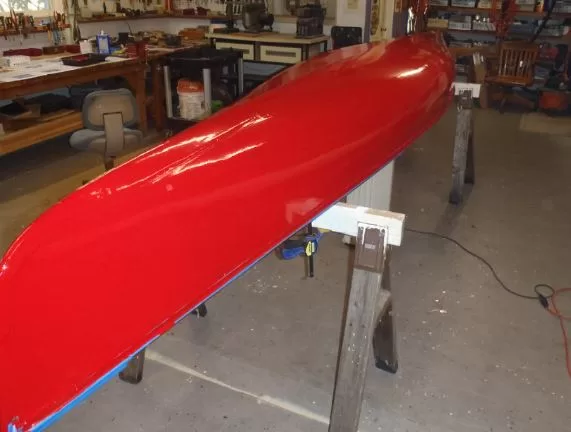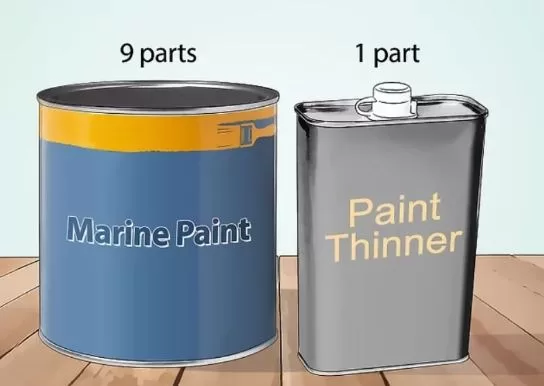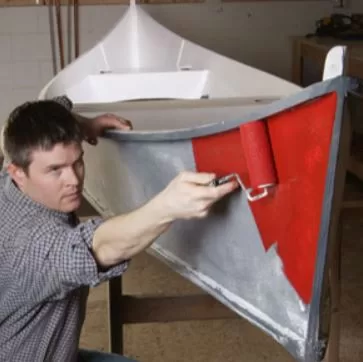Are you tired of your fiberglass canoe looking dull and faded? Do you want to give it a fresh new look? Painting your canoe is a great way to do just that! Not only will it make your canoe look brand new, but it will also protect it from the elements.
In this blog post, we’ll review everything you need about painting a fiberglass canoe. We’ll dig into the details of gel coats, polyurethanes, and resins, from the careful priming and sanding procedure to the application of marine-grade paint. So, grab your paintbrush, and let’s get started!
Key Takeaways – Painting A Fiberglass Canoe
How painting a fiberglass canoe is different from other canoe types – Fiberglass canoes require more sanding than others to ensure the paint adheres properly. When painting a fiberglass canoe, it is recommended to use marine-grade paint designed to withstand exposure to water and the elements. Spray painting a fiberglass canoe is not recommended, as the color may not hold up well in water.
What essential Materials do I need to have?
– Sandpaper
– Gelcoat repair kit
– Marine paint
– Primer
– Topcoat
– Paintbrush and small paint roller-
– Fiberglass resin
How do I paint a fiberglass canoe – Clean and sand the surface with medium-grit sandpaper to prepare it for painting. If there are any major cracks or gouges in the fiberglass, use a gel coat repair kit to fix them before painting. And lastly, apply fresh coats of paint using a paintbrush and a small paint roller.
Which painting technique is best for Fiberglass Canoes – The best painting technique for fiberglass canoes is to use oil-based marine paint. Rustoleum spray paint is also recommended as it works great and is strong against scratches, plus it has great color choices.
It is not recommended to use spray paint as it is not designed to be used in water, and the color will not hold up.
Does painting your canoe affect its performance and make it heavy – Painting a fiberglass canoe can add some weight and potentially affect its performance, but the impact is usually so minimal that almost no effect can be felt or seen.
In order to minimize the negative impacts, the right color and proper preparation must
Why is it important to paint a fiberglass canoe?
Here are some of the important reasons why it is important to paint your fiberglass canoe:
- Protection: A fresh coat of paint can help protect the fiberglass from the elements, such as UV rays, saltwater, and moisture, which can cause damage and corrosion over time.
- Durability: Marine-grade paint is designed to withstand the harsh marine environment and can provide a durable and long-lasting finish for a fiberglass canoe.
- Maintenance: A painted surface is easier to clean and maintain than an unpainted surface. Paint can help repel dirt, grime, and other debris, making it easier to keep the canoe looking clean and new.
- Customization: Painting a fiberglass canoe allows for customization and personalization. You can choose from various colors and finishes to create a unique look that reflects your style.

How painting a fiberglass canoe is different from other canoe types?
Painting a fiberglass canoe is different from other canoe types in a few ways:
- Surface Preparation
Fibreglass canoes must be well-cleaned and sanded before painting. This is because paint may stick poorly to fiberglass since it is smooth and non-porous.
Wooden canoes, for example, need special preparation methods, such as sanding and sealing the wood.

- Type of Paint
A fiberglass canoe may have different paint than other canoe types. Marine-grade paint is suggested for fiberglass canoes since it is made to survive exposure to water and UV radiation.
Various canoe types may require different paint kinds, such as oil-based paint for timber canoes.
- Repairing cracks and gouges
Fiberglass canoes may need to repair any significant fractures or gouges using a gel coat repair kit before painting. This is because fiberglass is prone to degradation and breaking over time.
Different repair methods may be required for various canoe types, such as using wood filler to patch fractures in wooden canoes.
- Painting technique
A fiberglass canoe may be painted differently than other canoes. For fiberglass canoes, brush painting is usually suggested to give equal coverage and greater control.
Preparation Before Painting Fiberglass Canoe
- Gathering the necessary materials
You will need marine paint or acrylic enamel paint, paintbrushes, a small paint roller, masking tape, sandpaper, a gel coat repair kit (if required), and paint thinner.
- Choosing the right paint
For best results, use acrylic enamel paint or marine paint. For fiberglass boats, Rustoleum spray paint is another excellent choice.
- Cleaning the canoe
Wash the canoe with soapy water and a sponge to get rid of any mud or grime. Dry the boat fully after a thorough rinse.
- Removing the Stickers from the Canoe
Remove stickers or logos of the canoe using a plastic scraper or a heat source. You should avoid scratching the surface at all costs.
- Sanding the surface
To ensure the paint sticks to the canoe’s surface, sand it using medium-grit sandpaper. Sand any rough edges or places where the paint is peeling.
- Filling any cracks or holes
Use a gel coat repair kit to fix up any significant cracks or gouges before painting the canoe.
- Applying primer (optional)
If you want to ensure the paint adheres to the surface, apply a primer before painting. However, this step is optional.
Painting Process
Selecting the appropriate painting technique
1. Brushing

The most conventional and simple method for painting a canoe is brushing. Paint the surface evenly with a paintbrush from one end of the canoe to the other. For little areas or touch-ups, this approach works well.
2. Rolling
A common method for painting bigger portions of a canoe is rolling. Apply the paint evenly, working your way from one end of the canoe to the other, using a tiny paint roller.
3. Spraying
The most precise and accurate method of painting a boat is spraying. Apply the paint evenly in layers, working your way from one end of the canoe to the other using a spray gun. This method may produce a smooth, uniform finish but requires some skill and practice.
Applying the first coat of paint
Use a paintbrush and a small paint roller to begin painting the marine paint with the first layer. It is advised to use thinner to dilute the paint by 10%. Roll out a 2-by-2-foot area with the roller, then quickly smooth it up with a high-quality roller.
Sanding between coats
After the initial layer has dried, softly sand the surface with a fine-grit sandpaper. This increases adhesion between applications and helps provide a smooth finish.
Applying additional coats
You need to apply at least one or two coats of marine paint, with a drying period between each application. The number of coats can vary depending on your personal preference and the desired level of coverage.
Curing and drying time
In the end, you will need to allow the paint to dry and cure according to the paint manufacturer’s instructions. The curing and drying process can take up some time, even days.
Finishing Touches
Applying a protective clear coat (optional)
To protect the paint job and add shine, you can apply a clear coat over the final coat of paint. This is optional but recommended for added durability.
Polishing and buffing
Once the paint and clear coat have dried, you can polish and buff the surface to create a smooth and shiny finish. Use a polishing compound and a buffing wheel to achieve the desired level of shine.
Adding decals or designs (optional)
If you want to add a personal touch to your canoe, you can add decals or designs to the surface. Make sure to apply them after the final coat of paint and clear coat have dried completely.
Maintenance and Care
- Cleaning the painted surface
After each use, wash the canoe with mild soap and water to remove any dirt or debris. This will help prevent buildup and protect the paint.
- Inspecting for damage
Regularly inspect the surface of the canoe for any signs of damage, such as cracks or chips in the paint. If you notice any damage, repair it as soon as possible to prevent further damage.
- Touching up paint as needed
Over time, the paint on your canoe may start to fade or chip. To keep it fresh, touch up the paint using marine paint as needed. Make sure to clean and sand the surface before applying new paint.
Important Tips to Remember While Painting Fiberglass Paint
Painting a fiberglass canoe can be a great way to give it a fresh or new look. However, it is important to follow the right steps to ensure that the paint job lasts and looks great.
Here are some important tips to remember while painting a fiberglass canoe:
- Prepare the surface: Before painting, it is important to clean the surface thoroughly with soapy water and sand it with 150- to 400-grit sandpaper until the gel coat is slightly dull. This will give the surface enough tooth to hold the primer.
- Apply primer: A special primer coat improves adhesive properties over the gel coat. You can use a brush or a spray gun to apply the primer. If you would rather not use a primer, you can wipe down the surface with a solvent such as acetone.
- Smooth-out surface irregularities: All surface irregularities must be smoothed out, old holes and cracks filled, and the surface sanded smooth.
- Mask areas you don’t want to paint: Use painter’s tape to cover the areas you do not want to be painted.
- Paint under the right weather conditions: To achieve the best results while painting your fiberglass boat, use the weather to your advantage. Paint in a dry, well-ventilated area and avoid painting on a windy day or in direct sunlight.
- Take your time: Painting fiberglass requires patience and attention to detail. Take your time and go slowly, especially between layers of primer, paint, and topcoat (if you use it).
Is Spray Paint for a Fiberglass Canoe recommended or not?
The use of spray paint for a fiberglass canoe is not recommended. While some sources suggest using Rustoleum spray paint for fiberglass canoes, others advise against using spray paint because it is not designed for water use, and the color will not hold up. (Source)
Do I need to remove any hardware before I start painting?
Removing any hardware before starting the painting process is generally recommended when painting a fiberglass canoe.
This includes plates, handles, or any other attachments not part of the fiberglass hull. Removing the hardware allows you to clean and sand properly and makes accessing the entire canoe surface easier, ensuring the paint is applied evenly and smoothly.
It also helps to protect the hardware from accidental paint splatters or damage during the painting process.
Can I create different patterns on my FiberGlass Canoe?
Yes, you can create different patterns on your fiberglass canoe. One way to do this is by using a sponge to apply marine paint of a different color on top of the solid base coat.
You can also create decorative patterns using other techniques, such as painting or staining the wood trim or adding decals.
If you want to create a camouflage pattern, you can use various techniques, such as painting blotches, branches, leaves, or other shapes that mimic natural elements in your surroundings.
Specific Precautions I Should Take While Paint for fiberglass canoe
Painting your canoe can be a challenging task, and for that, here are some specific precautions you should take while painting a fiberglass canoe:
- Clean and sand the canoe to prepare it for painting. Remove all dust remaining using a tack cloth. Wipe down the entire area to be painted with the thinner recommended for the paint you are using.
- Tape off all non-fiberglass parts on the canoe with masking tape. Cover any metal or wood pieces along the hull, such as gunwales and end caps, with masking tape.
This will protect them while you paint, so you don’t have to worry about accidentally getting paint on them.
- When painting fiberglass, use a primer compatible with the material, such as an epoxy or urethane primer. The surface should also be sanded to create a rough texture to help the paint adhere better.
- Apply the paint in thin, even coats, and allow each coat to dry completely before applying the next one. This will help prevent drips and ensure a smooth finish.
- Work in a well-ventilated area to avoid inhaling fumes from the paint. Wear a respirator mask if necessary.
- If you use a spray gun to apply the paint, cover the surrounding area with plastic sheeting to protect it from overspray.
- Dispose of any leftover paint and solvents properly, according to local regulations.
FAQs – fiberglass canoe paint
Can anyone paint his/her fiberglass canoe?
Yes, anyone can paint their fiberglass canoe. However, following the proper preparation and painting techniques is important to ensure a successful and long-lasting finish.
This includes cleaning and sanding the surface of the canoe, repairing any major cracks or gouges, choosing the right type of marine-grade paint, and applying the paint with a brush and roller.
What does the thinner do?
The thinner is a solvent used to thin out the paint and make it easier to apply to the fiberglass surface. It helps the paint spread evenly and smoothly across the surface, reducing the risk of drips and uneven coverage. Thinner is also used to clean up any excess paint or residue after painting.
How many coats should I apply while painting the fiberglass canoe?
When painting a fiberglass canoe, it is generally recommended to apply two coats of marine-grade paint for a smooth and durable finish.
Applying multiple coats helps ensure even coverage and enhances the paint job’s longevity. After the first coat has dried for 24 hours, it is advisable to lightly sand the canoe before applying the second coat.
This helps to create a smooth surface and promotes better adhesion of the subsequent coat. (Source)
What type of paint should I prefer for painting a fiberglass canoe?
When painting a fiberglass canoe, it is recommended to use marine-grade paint specifically designed for use on boats and watercraft. Here are some of the best types of paint to use for painting a fiberglass canoe:
- Rust-Oleum Marine Topside Paint: This is a popular choice for fiberglass canoes, as they are durable and can withstand water and UV rays. It is also available in a range of colors and finishes.
- One-part polyurethane marine paint: This paint is also recommended for fiberglass canoes, as it provides a durable and long-lasting finish. It is available in various colors and finishes and can be thinned with a compatible thinner for easier application.
- Specialty paint made for marine coatings: This type of paint is designed for use on boats and watercraft and is ideal for use on fiberglass canoes. It provides a durable and long-lasting finish and is available in various colors and finishes.
How long does it take for the paint to dry and cure on a fiberglass canoe?
The paint on a fiberglass canoe will typically be dry to the touch within 24 hours. This means that you can handle the canoe without the paint smudging or transferring.
As for the curing time, waiting at least 48 hours before using the canoe or putting it in the water is recommended. This allows sufficient time for the paint to fully cure and harden, ensuring better durability and resistance to water and other elements.
Should I apply a clear coat over the painted surface for added protection?
Applying a clear coat over a fiberglass canoe’s painted surface is unnecessary for added protection. Most marine-grade paints are designed to withstand water and UV exposure without a clear coat.
However, some sources suggest that a clear coat can be applied for optical reasons or to provide an extra layer of protection. (Source)
Can I use regular household paint for a fiberglass canoe, or do I need marine-grade paint?
No, you can not use regular household paint for a fiberglass canoe. Regular household paint is not designed to withstand prolonged exposure to marine environments and may not adhere well to the fiberglass surface.
Instead, you should use marine-grade paint specifically designed for boats and can handle the harsh marine environment.
Can I remove the existing paint from a fiberglass canoe before repainting it?
Yes, you can remove the existing paint from a fiberglass canoe before repainting it. One way to remove paint from fiberglass is to use an alkaline paint stripper like Hempel 99540.
Another way is to use fiberglass resin to fill small holes and cracks and then sand the canoe to remove the paint.
Can I also paint the fiberglass canoe’s interior, or is it only for the exterior?
Yes, you can paint the interior of a fiberglass canoe. A gel coat repair is recommended to fill in deep scratches or gouges before painting the canoe.
But it is important to keep in mind that the paint used for the canoe’s interior should be durable and long-lasting. Therefore, alkyd enamel and a high-quality latex primer or an oil-based primer can be a great choice.
How long can I expect the paint on a fiberglass canoe to last before it needs repainting?
The longevity of the paint on a fiberglass canoe depends on several factors, such as the quality of the paint, the exposure to the elements, and the frequency of use.
Marine paint for a fiberglass boat should last for years if it is easy to apply and keeps the deck nonslip, and paint for a fiberglass boat bottom typically lasts only two years before a repaint is necessary because of marine growth or corrosion.
It is important to note that using a good primer can bump up the longevity of the paint by a few years or limit the finish’s exposure to the elements. (Source)

Jack Bennett, a passionate pedal boating enthusiast, and marine engineer by day, is here to share my knowledge and love for this exciting sport with you all. Happy Boating!
